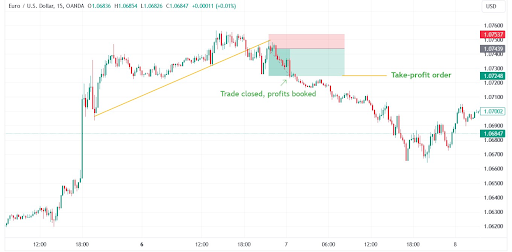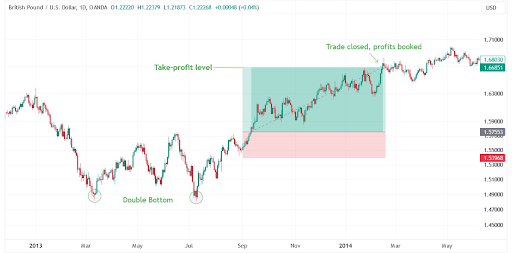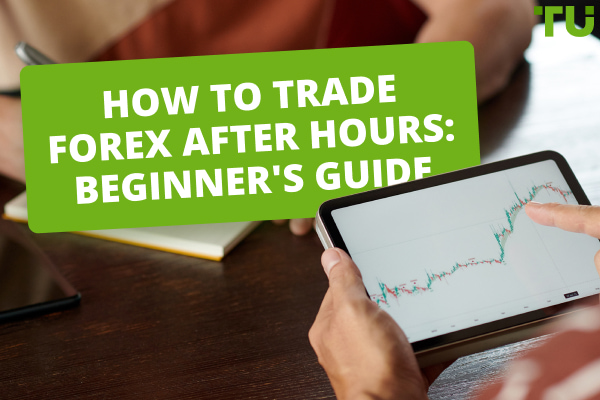What is a Take-Profit Order in Forex?
In Forex trading, a take-profit order is a predefined instruction that a trader sets to automatically close a position when a specified profit level is reached. Take-Profit Orders allow traders to mitigate potential losses, lock in their gains, and of risk management.
In Forex trading, it is essential to balance potential profits with effective risk management. Take-profit orders are a valuable tool for achieving this balance between risk and reward. Essentially, a take-profit order is a specific instruction to your broker that goes like "Close my position when it hits a certain profit level." In this article, experts at TU will walk you through the fundamentals of take-profit orders, what they are, how to use them, and the different types you can explore. Additionally, they will share some expert tips to help you pick the perfect take-profit order that aligns with your trading style.
Introduction
What is a Take-Profit Order?
A wise trader once said, 'Greed never leads to success; a well-placed take-profit order does.’ In Forex trading, a take-profit order is a predefined instruction that a trader sets to automatically close a position when a specified profit level is reached. This order is designed to lock in profits by exiting a trade at a favorable price.
Take-profit order is also an important component of risk management in Forex trading. The key principle behind it is to capitalize on favorable market movements and secure gains without the need for continuous monitoring.
Why are Take-Profit Orders Important in Forex?
While the generic idea of take-profit orders is simple, traders employ them for varied reasons, including
-
Lock-in profits – Think of take-profit orders as your financial bodyguard. By setting a specific price at which a trade will be closed, traders can capture gains when the market moves in their favor. Without a take-profit order, traders risk watching potential profits evaporate if the market reverses. For example, let’s say you buy a stock at $50 and set a take-profit order at $60. The take-profit order ensures you automatically cash in your winnings when the stock price hits $60. This way, it shields you from potential reversals. Though it’s important to note that you are likely to miss out on further upside if your quantity input is equal to your entire inventory. You can also be interested in information about How To Take Profits From Stocks.
-
Take profits when you're not able to monitor the market – The Forex market operates 24/5, which poses a unique challenge for traders who can't be available all the time. In such a scenario, take-profit orders come to the rescue. These orders act as automated safeguards as they close positions as soon as the rate reach specified profit levels. This approach ensures that traders can stick to their profit targets and limit losses even if they're not actively watching the market.
-
Improve risk management – The inherent volatility of the currency exchange market can expose traders to substantial risks. To mitigate these risks, traders use various techniques and tools. Stop-loss and take-profit orders are two essential components of this risk management approach. A stop-loss order helps limit potential losses by specifying a predetermined exit point if a trade moves against the trader. In contrast, take-profit orders secure profits by setting a target price for closing a position when the market moves favourably. Ideally 2:1 risk-reward ratio is followed as a common adage, and the same can be achieved using take-profit and stop-loss orders. For example, if a trader enters a long trade at $10, they can simultaneously also execute a take-profit order of $12 and stop-loss order of $9, effectively locking-in a risk-reward range of 1:2. Though it’s important to note that the actual sell and buy levels may vary based on how volatile the currency pair is.
-
Limit Losses – While this may sound counter-intuitive, any profit not booked is practically a loss. So effectively, take-profit orders serve as a protective mechanism against potential losses in terms of lost profit.
How to Place a Take-Profit Order
Setting up a take-profit order is a straightforward process. It can typically be done through your trading platform by following these steps
-
Select your trade – Identify the open trade for which you want to place a take-profit order. Let’s understand it with a simple example. You've initiated a trade by buying 10 lots of EUR/USD at 1.1500, expecting its value to rise.
-
Set the price – Set the price trading strategy and analysis. After conducting technical analysis , you determine that a price of 1.1600 aligns with your profit target. This price level suits your trading strategy.
-
Specify the volume – Indicate the volume or lot size for the trade. This determines how much of the position will be closed when the take-profit level is reached. You specify that you want to close 5 lots of your 10-lot position when EUR/USD reaches 1.1600.
-
Confirm the order – Double-check all details, including the price and volume, to ensure accuracy. You ensured that the take-profit price at 1.1600, closing half of your position (5 lots), aligning with your strategy.
-
Place the order – Once you're satisfied with the parameters, execute the take-profit order. It will be stored in the system until the specified price is met. You have executed the order and It's now in the system and ready to automatically close 5 lots of your trade when EUR/USD hits 1.1600.
Different Types of Take-Profit Orders
Forex traders have access to various types of take-profit orders to suit their specific trading strategies. Here are some common variations
-
Limit order
This is the most basic form of a take-profit order. It specifies the exact price at which a trade will be closed to lock in profits. The simplicity and precision of this order makes it a favorite among traders.Example. If you buy the EUR/USD currency pair at 1.1500, you might set a Limit Order to take profits at 1.1600. When the market reaches this level, your trade is closed and you've achieved your desired profit.
-
Percentage-based take-profit
The Percentage-based Take-Profit order is a versatile choice for traders who prefer a more flexible approach. Instead of specifying a particular price, this order allows you to close a trade when a certain percentage gain is achieved.Example. As a general rule of thumb, traders should not risk more than 2% of their entire capital in a single trade. Keeping the same in mind, a trader targeting a risk-reward ratio of 1:2 can place a take-profit order of 4% when using this variation of the tool.
-
Trailing take-profit
This order is dynamic and intelligent, moving in tandem with the market. It adjusts your take-profit level as the market moves in your favor allowing you to capture more substantial gains during strong trends.Example. Suppose you're trading the USD/CAD currency pair, and you set a trailing take-profit order at 50 pips. As the market starts moving in your favor, the order will adjust its closing price. If the market moves 50 pips in the opposite direction, your trade closes and your profits are locked. However, if the market keeps moving in your favor, the trailing take-profit order continues to adjust and enables you to capitalize on an even more significant gain.
-
Time-based take-profit
This order gives you the flexibility to specify a particular time for your trade to close, irrespective of the price level. It's a valuable tool for traders who prefer not to leave positions open overnight or want to align their trading with specific timeframes.Example. If you're trading the AUD/USD currency pair, you might place a time-based take-profit order to close your position at 5:00 PM GMT, regardless of the current market price. This approach allows you to trade with more control over your schedule and minimize exposure to overnight market fluctuations.
Benefits of Using Take-Profit Orders
-
Customization – Take-profit orders come in various forms and offer traders a wide range of options to suit their specific strategies and objectives. Whether you prefer to close trades at exact price levels, specific percentages, or based on time, you can customize your take-profit orders to align with your trading style.
-
Reduced stress – Take-profit orders enable you to maximize your profits by closing trades at predetermined levels. You can capitalize on favorable market movements ensuring that you capture gains. This proactive approach ensures that you secure profits when the market is in your favor.
-
Discipline and emotion control – Emotions can be detrimental to trading decisions. Take-profit orders enforce discipline by removing the temptation to hold onto a winning trade for too long or hope that it will turn around after a loss. You execute your strategy precisely as planned, free from impulsive actions driven by fear or greed.
-
Optimal entry and exit timing – Take-profit orders encourage you to plan your trades with precision. You not only determine your entry points but also define your exit points in advance. This ensures that you enter and exit trades at the most advantageous moments in the market.
How to Set Effective Take-Profit Orders
To make the most of your take-profit orders, consider the following tips
-
Consider your risk tolerance – The level of risk you are comfortable with should play a significant role in determining the take-profit levels. A conservative trader may opt for lower profits with reduced risk while a more aggressive trader might aim for larger gains with higher risk.
-
Use technical analysis – Utilize technical analysis tools and indicators like moving averages to identify potential price levels where the market may reverse or encounter resistance. These levels can serve as effective take-profit points.
-
Logical resistance levels – Resistance levels, as identified through technical analysis, are often good candidates for take-profit orders. They represent price points where the market has previously struggled to move beyond. You can consider psychological resistance levels (price levels in multiples of 10 pips, 100 pips, or 1000 pips, depending upon the current price level of the pair).
-
Trailing take-profit – Trailing stop-loss orders can complement take-profit orders by adjusting the exit point as the market continues to move favorably. This dynamic approach can maximize profits during strong trends.
Examples of Take-Profit Orders in Forex
To illustrate the practical application of take-profit orders, consider the following examples

EUR/USD Short Trade
You enter a short trade at 1.07439 having a bearish outlook for the EUR/USD currency pair. You then place a take-profit limit order at 1.07248 given that there are chances of support there. As the market reaches this point your trade automatically closes and profits are locked without your manual intervention.

EUR/USD Long Trade
Anticipating a GBP/USD depreciation, you short the pair at 1.57553. Using the double bottom strategy, you set the take-profit order at the neckline to bottom distance (1.66851). As GBP/USD hits 1.1.66851, the take-profit order is activated and the trade is closed.
Conclusion
For any Forex trader, the use (or at least the knowledge) of take-profit orders is very important. These orders allow traders to mitigate potential losses, lock in their gains, and of risk management. To harness the full potential of these orders, one must start by assessing their own risk tolerance which paves the way for wise decision-making. Additionally, technical analysis help traders to identify the opportune moments to set a take-profit order.
Also, real-world examples help us understand the role take-profit orders play in modern Forex trading. They offer a level of control and automation which is very important in a volatile market that never sleeps. By incorporating these orders into your trading strategy, you're better equipped to reach your financial goals while minimizing potential losses.
Best Forex brokers

FAQs
Does take profit automatically sell?
Yes, a Take-Profit order automatically sells (or closes) a trade when the specified price level is reached and helping traders secure profits without human intervention.
Why use a limit order?
A limit order is a trading instruction that specifies the exact price at which an asset should be bought or sold. Traders use it to gain more control over their trades and ensure execution at desired price levels. This order type is a fundamental tool for disciplined trading and risk management.
Can I Set a Take-Profit Order to Close at a Specific Time?
Yes, you can set a time-based take-profit order to close a trade at a specific time. This can be helpful for traders who prefer not to leave positions open overnight or want to ensure that a trade is closed at a particular time to align with their trading strategy or schedule.
Can I cancel a take profit order?
Yes, you can cancel a take-profit order in Forex. Most trading platforms allow traders to easily cancel or modify existing orders. Simply access your trading platform, locate the trade with the active take-profit order, and follow the platform's instructions to cancel or adjust the order to your desired preferences.
Team that worked on the article
Chinmay Soni is a financial analyst with more than 5 years of experience in working with stocks, Forex, derivatives, and other assets. As a founder of a boutique research firm and an active researcher, he covers various industries and fields, providing insights backed by statistical data. He is also an educator in the field of finance and technology.
As an author for Traders Union, he contributes his deep analytical insights on various topics, taking into account various aspects.
Dr. BJ Johnson is a PhD in English Language and an editor with over 15 years of experience. He earned his degree in English Language in the U.S and the UK. In 2020, Dr. Johnson joined the Traders Union team. Since then, he has created over 100 exclusive articles and edited over 300 articles of other authors.
The topics he covers include trading signals, cryptocurrencies, Forex brokers, stock brokers, expert advisors, binary options. He has also worked on the ratings of brokers and many other materials.
Dr. BJ Johnson’s motto: It always seems impossible until it’s done. You can do it.
Mirjan Hipolito is a journalist and news editor at Traders Union. She is an expert crypto writer with five years of experience in the financial markets. Her specialties are daily market news, price predictions, and Initial Coin Offerings (ICO). Mirjan is a cryptocurrency and stock trader. This deep understanding of the finance sector allows her to create informative and engaging content that helps readers easily navigate the complexities of the crypto world.










